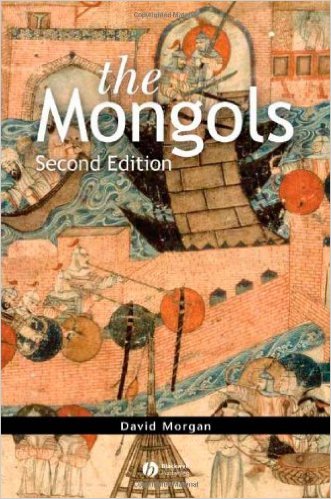Join us for a free one-day workshop for educators at the Japanese American National Museum, hosted by the USC U.S.-China Institute and the National Consortium for Teaching about Asia. This workshop will include a guided tour of the beloved exhibition Common Ground: The Heart of Community, slated to close permanently in January 2025. Following the tour, learn strategies for engaging students in the primary source artifacts, images, and documents found in JANM’s vast collection and discover classroom-ready resources to support teaching and learning about the Japanese American experience.
May, The Return of the Mongols, 2007
David Morgan. The Mongols. Second edition. The Peoples of Europe Series. Malden: Blackwell Publishing, 2007. xxi + 246 pp. Illustrations, maps, tables, bibliography, index. $29.95 (paper), ISBN 978-1-4051-3539-9.
Reviewed for H-War by Timothy May, Department of History, North Georgia College and State University
Published by H-War@h-net.msu.edu (October, 2007)
The Return of the Mongols
The standard book on the Mongols is and has been David Morgan's classic work, The Mongols. After twenty years and many more reprintings, it has finally been replaced by itself in a second edition. First published in 1986 as part of Blackwell's Peoples of Europe series, unlike the real Mongols it never migrated into a more appropriate location, such as the newer Peoples of Asia series, which did not exist when the book was first published.
it has finally been replaced by itself in a second edition. First published in 1986 as part of Blackwell's Peoples of Europe series, unlike the real Mongols it never migrated into a more appropriate location, such as the newer Peoples of Asia series, which did not exist when the book was first published.
On the whole, none of the original text has changed. This can be disconcerting when reading outdated bibliographic statements, such as that a biography of Qubilai Khan does not exist (p. 104), when Morris Rossabi published an excellent one, Khubilai Khan, His Life and Times, in 1988. It is equally bothersome to read statements that show their age, such as "the conquest of China, especially north China, had always been every steppe ruler's dream, and Chingiz was no exception" (p. 13). As a former student of the good Professor Morgan, I know quite well that he takes considerable delight in informing his students that "the historian Morgan is just wrong on this."
So why would a second edition be printed with such errors? Rather than trying to rework a second edition by correcting outdated information here and there, Morgan instead opted for adding an additional chapter (chapter 9) entitled "The Mongol Empire since 1985." Here he discusses the new information concerning primary sources and secondary studies on the Mongols. Although it would have been nice to have corrected and updated individual chapters, in many ways this method is preferable. Correcting the original edition would have required a major overhaul, particularly in trying to add new literature in footnotes. Overall, since the first edition remains accurate for the big picture of the Mongol Empire, a reworking was not necessary. The additional chapter, written again in the effortless and accessible prose for which Morgan is known and which makes _The Mongols_ perfect for the classroom, also serves as a vehicle in which Morgan corrects outdated views and information that has since been deemed incorrect. The chapter provides a discussion of some of the more important publications that appeared between the first and second editions. Furthermore, it demonstrates just how much a field can change over twenty years. This, in itself, more than justifies Morgan's approach to the second edition.
In addition to the new chapter, Morgan includes a supplementary bibliography which incorporates publications that have appeared since 1985. Although not comprehensive, and Morgan does not claim that it is, it is as close as one can get with such a broad and wide-ranging field.
Although many of the studies Morgan discusses in chapter 9 are not directly related to the military, he includes numerous references that will provide a greater understanding of the Mongols' mindset and ambitions. He offers a discussion of primary sources that are now available in English translation, such a Rashid al-Din's Compendium of Chronicles, which in 1986 was available in the original Persian and in Russian translation. One new work, published just months after the publication of the new edition of The Mongols, that Morgan did notinclude in his discussion of new studies or in the supplementary bibliography, is The Mongol Art of War by Timothy May.
In summary, the second edition of The Mongols remains the standard work on the Mongols. With the additional chapter and bibliography it is unlikely to be superseded in the near future and will be a useful reference to any scholar.
Copyright (c) 2007 by H-Net, reprinted by permission for educational and non-commercial use.
Featured Articles
Please join us for the Grad Mixer! Hosted by USC Annenberg Office of International Affairs, Enjoy food, drink and conversation with fellow students across USC Annenberg. Graduate students from any field are welcome to join, so it is a great opportunity to meet fellow students with IR/foreign policy-related research topics and interests.
RSVP link: https://forms.gle/1zer188RE9dCS6Ho6
Events
Hosted by USC Annenberg Office of International Affairs, enjoy food, drink and conversation with fellow international students.
Join us for an in-person conversation on Thursday, November 7th at 4pm with author David M. Lampton as he discusses his new book, Living U.S.-China Relations: From Cold War to Cold War. The book examines the history of U.S.-China relations across eight U.S. presidential administrations.




